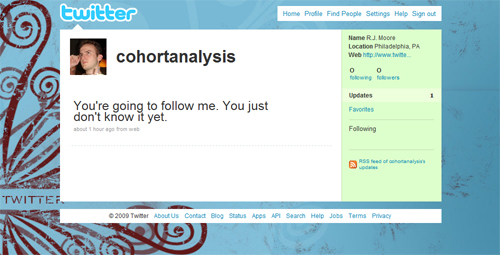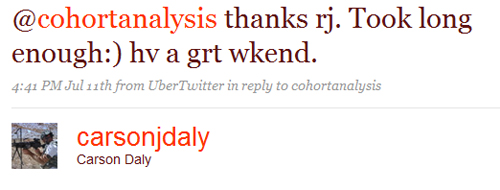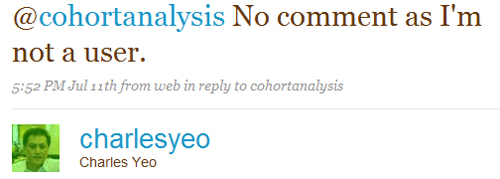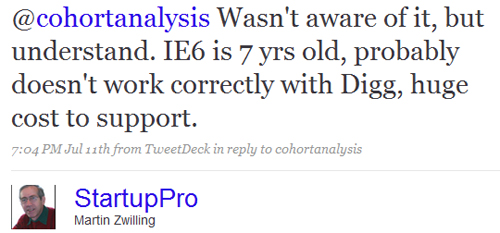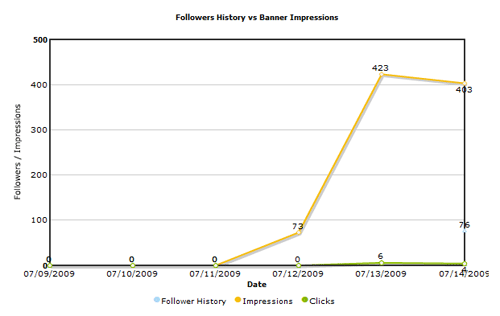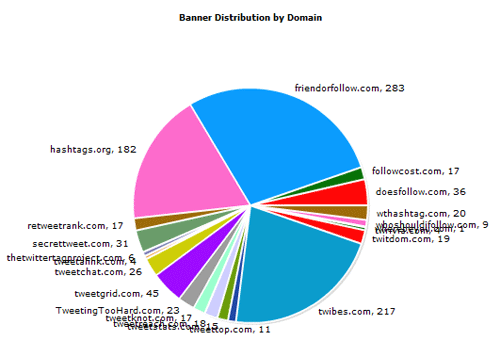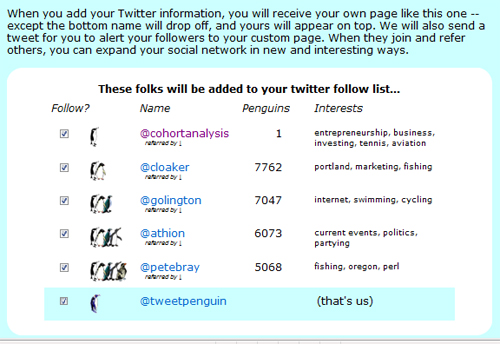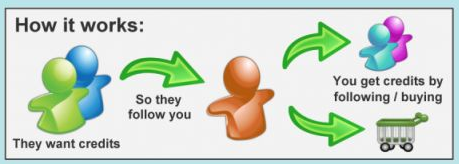This article provides an in-depth look at the major tricks and techniques for gaining Twitter followers. These include organic (i.e. legitimate) growth, paid services, and shortcut “tricks” used by the most-followed nobodies on Twitter.
We provide detailed, data-driven conclusions about the effectiveness of each technique and its real cost to the end user. The impact of follower acquisition campaigns are heavily interconnected (as shown in the chart below), but we make an effort isolate the effects of each in a fair way.
A more detailed explanation of this chart is provided in the “Preparation” section below
If you enjoy this article, please be sure to follow us @RJMetrics to stay informed about future updates and our powerful business intelligence dashboard software.
Why Should We Care?
I’ll admit it: I’ve done my fair share of Twitter-bashing. Spending a few years in late-stage venture capital has made me pretty closed-minded about any company that raises mountains of cash but makes less money than a twelve year-old with a paper route.
For better or worse, however, Twitter followers have become a proxy for influence in the digital world. Unfortunately, the big problem with relying on this particular proxy for popularity is that it can be faked. Easily.
Even worse, placing emphasis on this particular metric encourages fakers. Yes, the guy with 30,000 followers might have accumulated them deceptively, meaning there is a risk that he is secretly a huge loser. But, the undeniable loser is that guy with only 30 followers. After all, nobody fakes unpopularity!
So, just how easy is it to rack up a huge base of followers? I decided to identify and test out every method I could find for accumulating followers quickly. My end goal was to accumulate a master list of follower acquisition methods, their effectiveness, and the time and/or monetary costs involved.
Types of Followers
Before we begin, I want to define two important terms that I will use frequently: FreeFollowers (users who follow you without you following them back) and ReFollowers (users who are only follwing you because you followed them).
As you might be able to guess (and as we will quantify later) ReFollowers are much easier to acquire than FreeFollowers because they’re getting some reciprocal value (another follower) out of the relationship regardless of your tweet quality. FreeFollowers, however, actually have to want to follow you because of who you are or what you say.
Whether or not you choose to take the easy road and go after ReFollowers should depend on your goals. If all you care about is a large number of followers and you’re less concerned with follower loyalty or the quality of your Twitter experience, ReFollowers may be your answer. However, if you do care about these things, I would avoid mass ReFollower acquisition for two reasons:
- The key functionality of Twitter will be impaired because your stream of updates will be extremely cluttered, making it difficult to actually “follow” anybody. You’ll never realistically be able to discover new and interesting users because of the overwhelming amount of disjointed information in your update stream.
- Many of your followers will also be ReFollow junkies. This means that they will suffer from the same cluttered update stream as you, diminishing your actual “reach” (the average number of followers who actually read any given Tweet you send).
As a general rule, I like to assess the true popularity of a Twitter user by subtracting the number of people they follow from the number of people following them. If you look at the users with over 25k followers, you’ll find that many of them have a negative or very low value when you do this calculation. These people are using ReFollow tricks, the easiest method for artificially inflating their numbers (explained later).
Obviously, these users are gaming the system and provide more noise than signal in the Twitter universe. If you find yourself becoming one, make sure you’re OK with the implications.
Preparation
It’s time to start gaining followers! To give us a clean slate and avoid the risk of losing my account if things get too shady, I created a completely new Twitter account for this experiment. It’s owned by my alter ego, R.J. Moore.
Before we start, one disclaimer: some of these techniques might get our account banned from Twitter if we use them irresponsibly. The following reasons for a banned account have allegedly been provided by Twitter support. Keep them in mind as you build your follower growth plan:
- You’ve followed a large number of people in a short amount of time
- There is a small number of followers compared to number of people you’re following
- The updates consist mainly of links and not personal updates
- A large number of users blocking the profile and writing in with spam complaints
The following steps are designed to decrease our chances of getting banned and increase our “follower conversion rate,” which is simply the percentage chance that someone who sees our username ends up following us. We do this first so that our later attempts at gaining followers all get a fair shake.
Step 1: The Kevin Rose Basics
I like Kevin Rose, and not just because he’s a fan of my previous work. If you search Google for tips on how to gain followers, his guest post on TechCrunch will probably be one of the top results.
The post lists a lot of good (however obvious) ways to gain followers: fill out your bio, tweet about stuff people care about, self-promote your twitter page, stay on top of your stats, etc. I agree with all of this logic, so we’ll take some time to upload a photo and build a custom page layout for our new account.
Putting time into these basic techniques helps demonstrate that we’re not a spam account, which has a drastic impact on someone’s likelihood of following us.
Cost: 30 minutes
Step 2: Create a Content Base Coat
We aren’t going to get FreeFollowers unless they care about our tweets. And they can’t care about what we tweet if we haven’t tweeted anything. In order to start things off right, I sent out a half-dozen tweets that I hoped would be of interest to our target follower base. They were timely and relevant, but more importantly, they suggested that more interesting tweets would follow.
Cost: 15 minutes
Step 3: Create a “Following” Base Coat
Next, we need to follow some people. I used Twitter’s “Suggested Users” feature to find a handful of interesting candidates.
Following a small number of people (20 to 40) when we’re getting started shows that we’re engaged with the service and less likely to fade away like many new users do. This makes us a more viable “follow” in the eyes of a more selective user.
Total Cost: 10 minutes
Step 4: Create a “Follower” Base Coat
Next, we’ll go out and get our first followers. The logic is simple: the likelihood of someone following us increases with the number of people already following us:
- With less than a “base coat” of followers, we have no clout and this hurts our conversion rate.
- As the base coat is built, we receive a conversion rate bump based on the increased confidence that we are not a spam account.
- For the next several thousand followers, there is a small marginal benefit of a new follower.
- After we have reached a “large number” of followers (10,000+), we are perceived as a “celebrity” by the average user and our conversion rate experiences another steep increase period due to our perceived fame.
This concept is demonstrated in the utterly imprecise and unscientific chart below:
Note the logarithmic scale on the x-axis. This means that our first followers provide the greatest marginal benefit. As such, we should pick up as many followers as we can from our friends and existing contacts before going after strangers.
I put in my Gmail account information and detected which of my existing contacts were already on Twitter. I followed them all and most of them followed me back, providing a base coat of a few dozen legitimate followers.
Total Cost: 30 minutes
Execution
Now that our account is optimized for converting potential followers, it’s time to actually attract them.
Method 1: Topical Tweets
We’ll start with a very basic technique: saying things of interest to a large population of people. The goal here is to attract FreeFollowers (followers who we are not following us back).
Sites like hashtags.org list trending topics on Twitter (as does Twitter itself). These topics are typically identified by hashtags (words preceded by a “#” sign). Messages that include the most popular hashtags are both heavily tweeted and heavily searched.
We sent out 100 tweets, each with a statement related to one of the top few hundred hashtags (and including that hashtag). Our goal was to be seen by people who weren’t following us and convert them into followers.
It’s important that we tried out this method first, because it carries the risk of annoying our existing follower base. Sending 100 Tweets inside of two hours is going to annoyingly dominate our existing followers’ Twitter update streams, and this increases the risk that they will unfollow us.
We sent out 100 tweets using about 180 minutes of manpower. (Thanks to our interns Cheryl and Mario for helping with this!) These aren’t necessarily easy tweets to send since each requires some kind of clever message and an understanding of what the hashtagmeans. In the end, we added 15 followers from this initiative.
Cost Per FreeFollower: 12 minutes
Method 2: Direct Interaction
This is a similar technique, only instead of targeting the general public we target prospective followers directly. We search the same popular topics and respond to those users who are making comments. Our goal is to have them to follow us after the interaction (even though we haven’t followed them). Here again, we are targeting FreeFollowers.
Note that tweets starting with another user’s name don’t appear in your followers’ update streams. This means that you can respond to hundreds of tweets in a short time without annoying your existing followers.
These messages were easier to write than the previous ones, since they are mainly gut reactions to other people’s comments. Our team was able to send out 100 tweets in about 120 minutes, and we acquired 18 followers in the process. This was a hands-down better technique than Method 1 since it didn’t annoy our existing base and had a meaningfully lower average cost.
Cost Per FreeFollower: 7 minutes
Method 3: Celebrity Mentions
This is a bit of a high-risk, high-reward technique. If someone on Twitter with a large number of followers were to mention our username, it’s quite likely that some subset of their followers would check us out, and hopefully some subset of those would convert into followers.
I used the Twitter directory service WeFollow to find some good targets. I stayed away from the behemoths (Ashton Kutcher, Oprah, etc) and instead opted for any users with 25-100k followers.
I was able to do 50 tweets in about an hour. Here are the responses I got:
Carson Daly (32k followers, I complimented his terrible TV show)
Cuban Singer/Songwriter Jon Secada (96k followers, I asked what’s next)
Publisher Charles Yao (55k followers, asked him about Digg)
Startup Advisor Martin Zwilling (69k followers, asked him about Digg)
I ended up adding 6 followers as a result of these efforts, although I’ve got to imagine the volatility of a method like this is pretty high. If you had a reliable method for engaging celebrities, it could really pay off (although it’s probably not too scalable).
Cost Per FreeFollower: 10 minutes
Method 4: Purchase Users via Display Advertising (FeaturedUsers.com)
FeaturedUsers.com is the advertising engine used by a number of Twitter-related websites. You simply purchase inventory from them and an ad for your Twitter profile shows up on sites in their network. The ads pull your bio directly from Twitter and can’t be otherwise customized. They look like this:
The CPM (cost per 1,000 impressions) was a flat $10. I laid down a cool Hamilton so you don’t have to. After using up about 300 of my impressions, FeaturedUsers informed me that my clickthrough rate of 0.617% was below their network average of 0.837%. They offered the following tips for improving it:
- High quality headshots tend to perform better than brand logos.
- Including the phrase “If you follow me, then I will follow you” in your bio seems to help. But only include that phrase if you mean it.
- Original and odd Twitter bios tend to perform better than a bio that simply lists what you do or have done.
- Women’s profiles tend to fair better than men’s profiles in CTRs.
- Have a look at the top CTR performers and see what qualities their Twitter profile has that yours might be lacking.
The second bullet point is asking a lot (making you buy ReFollowers instead of FreeFollowers), but otherwise the information was helpful. I checked out the top performers and made a few modifications to help boost my clickthrough rate:
My conversion rate immediately doubled to around 1.2% and I was listed on the “top converting ads” page for the remainder of my campaign. When my inventory was all used up, I had generated 12 clicks, and the site provided these charts:
The 12 clicks led to 10 new followers, yielding a $1.00 cost per FreeFollower.
Cost Per FreeFollower: $1.00
Method 5: Purchase Users via Paid Tweets (Magpie)
Magpie is an advertising system for Twitter where you basically pay people to tweet your ad to their followers. You create a 130-word ad, agree to a maximum CPM and then it’s bombs away.
The system is super-easy, but two things struck me as odd. First of all, their CPM system seems to be bid-based in that you name a maximum CPM that you’re willing to pay. The traffic estimates imply that the minimum CPM you’ll ever pay is $3, but you’re forced to choose a maximum anywhere from $10 to $30 depending on your keywords.
This seems like a massive spread for ads that don’t have a “placement” factor like, say, Google Ads. These ads either run or they don’t, so what does the higher bidder win? I assume it’s to determine who gets the tweet if there is a shortage of inventory, but I’ve got to imagine there’s no shortage. After all, unlike in most display advertising, generating more inventory doesn’t necessarily require more followers. It just requires that you send more tweets.
The second thing that struck me was how high these maximum CPMs are. My $10 bid (the lowest it would allow) means that I’m paying up to $10 for every 1,000 followers of the person who tweets my ad. Since not every follower necessarily sees every tweet, the real “cost per impression” is probably much higher than $10, particularly if the tweeter has a low-quality follower base.
If you disagree, consider this: a $10 CPM implies that Ashton Kutcher, who has 2.7 Million followers and averages 16 tweets per day, creates $157 Million of prospective advertising inventory a year. Right.
Anyway, I bit the bullet and created a tweet to be sent out by people involved in “business” and “entrepreneurship.” I bid a $10 CPM, put the minimum $20 into my account and crossed my fingers. Magpie made me wait 3 days after paying them to approve and run my ad, which was frustrating (apparently they don’t work on the weekends). After the ad was approved, my entire budget was consumed on this single tweet:
The poster had 2,628 followers at the time of the tweet (which was 4PM on a Tuesday) and it cost me $19.09, meaning I was charged a $7.26 CPM. In the remainder of the day (enough time for a tweet to fade into the oblivion), the link received 15 clicks (a 0.57% click-through rate), but yielded only two followers. This means I paid a whopping $14.55 per FreeFollower.
In Magpie’s defense, I’m sure that responses vary heavily from tweet to tweet, and I am working with an admittedly small sample size. However, it’s undeniable that the clickthrough rate is quite low and the click-to-conversion rate is even lower.
Cost Per FreeFollower: $14.55
Method 6: Purchase Users via ReFollow Services
There are a number of businesses that will outright sell you followers. If you Google “get Twitter followers,” look at the ads, and find the ones that seem the most shady, those are the services I’m talking about here.
Below I list a representative subset of these businesses and the costs of their baseline packages:
- uSocial: 9 cents per follower
- TwitterPromoter: 10 cents per follower
- Twitboost: 10 cents per follower
- Get More Twitter Followers: 9 cents per follower
Few of these sites actually tell you how they do it, but “Get More Twitter Followers” is kind enough to offer a pretty transparent explanation of what’s going on:
“This service works by adding quality targeted followers over time by following people first, then waiting for a reciprocal follow back, then after a grace period, purging the non returning followers and repeating the process until we reach your purchased follower amount.”
In other words, these services sell you ReFollowersexclusively. As explained above, we know the pitfalls of a ReFollow-based strategy. With this new data, however, we are now able to quantify the cost of a ReFollower versus the cost of a FreeFollower (as dictated by the marketplace).
Our lowest effective FreeFollower price was about $1.00, while we can buy ReFollowers here for about 10 cents apiece. This suggests that the “value” of a FreeFollower is around 10X that of a ReFollower, which (if you think this is an efficient market and you tie value directly to reach) you could take to mean that a FreeFollower is 10X more likely to read any given Tweet you send out.
Cost Per ReFollower: $0.10
Method 7: Hosted ReFollow Services
Despite my personal aversion to ReFollow techniques, I think it’s worth exploring exactly how complex this process is and what kind of time it takes to do-it-yourself instead of purchasing something from a provider in the previous method.
Generally, here’s what we want to do:
- Identify users (typically ones who tweet certain keywords of relevance to us) and follow them.
- Give them a grace period of two days or so to follow us back, and if they haven’t done so, unfollow them. This prevents us from following dead weight.
I’m going to add an extra step here that is a bit more devious. After a few days of creating a new reciprocal relationship, I’m going to unfollow anyone I’m following (even the people who are following me), yielding new ”artificial” FreeFollowers but likely increasing the risk of losing them altogether. This is generally a huge faux pas in the Twitterverse, but I cared enough about getting the data to risk the bad Karma (especially with a dummy account).
I call these artificial FreeFollowers because of how they were acquired. The fact that they participated in a reciprocal ReFollow means they are likely to have a noisy update stream and therefore have a poor likelihood of reading our tweets. This makes them less valuable than a more legitimately-acquired FreeFollower. If you’re only interested in perception, however, this could be a great move because artifical FreeFollowers can’t be distinguished from true FreeFollowers.
Doing this manually through the Twitter interface would be pretty laborious, but thankfully the Twitter API has led to the creation of tools that help do it for you. We will look at two: Twollow and FlashTweet.
Twollow: Twollowallows for massive, scheduled, automated follows and unfollows. The service has a 7 day trial that is pretty watered-down. I sprung for their basic $6/month subscription to give it a real test.
Twollow does exactly what we wanted. It allowed us to follow up to 75 new keyword-specific people per “cycle” (every few hours). Then, it auto-unfollowed any of them who hadn’t followed us back after three days. This basically allowed us to sit back and accumulate ReFollowers with no effort whatsoever.
Twollow ended up following 203 users in its first 24 hours. I then waited another day to allow people to follow me back and ended up with 48 ReFollowers (a whopping 24% conversion rate). This after having spent only $6 and virtually no time. Assuming I could keep this up for my 30-day subscription, I would end up with 1,400 followers for just a $6 investment.
Cost Per ReFollower: $0.004
Remember, however, that these are ReFollowers. Even worse, while this process is going on we’ll be following a massive number of people. This isn’t going to look very good to an informed eye.
Now, for the devious step. I unfollowed everybody it had added (I used a free tool called Mutuality to do a bulk removal of everyone I was following) and waited another few days to see how many would drop me. I tracked this using another free tool called TwUnfollow that e-mails you every time someone unfollows you.
22 of my refollowers did, leaving me with a net gain of 26 artificial FreeFollowers. Extrapolating this suggests that we could gain up to 780 artificial FreeFollowers during our $6 subscription.
Cost per (artificial) FreeFollower: $0.008
In terms of posting numbers, this technique is untouchable in ease and cost. If you don’t care about the loyalty or reach of your base, Twollow is the way to go.
FlashTweet: This service is similar to Twollow, except that it’s free and lacks Twollow’s automation features. Using FlashTweet, you can identify and follow up to 100 users at a time based on keywords or relationships (i.e. followers of followers), but these adds are done in bulk at the time of request and can not be scheduled. You can also unfollow anyone who is not following you in bulk with a similar process.
FlashTweet carries a slightly higher banning risk than Twollow because its lack of automation lends itself to adding larger batches less frequently. However, if you have the time to log in on a regular basis and keep track of who to unfollow and when, you can absolutely generate similar benefits to Twollow.
It’s reasonable to assume you can achieve a similar yield of around 50 ReFollowers or 25 artificial FreeFollowers per day using FlashTweet. However, this requires an estimated 30 minutes of labor per day (which may decline with scale when you can add larger batches with less risk).
Cost per ReFollower: 36 seconds
Cost per (artificial) FreeFollower: 72 seconds
Method 8: Pyramid Schemes
If Bernie Madoff was on Twitter, he’d use tweet penguin. It’s a Ponzi scheme, plain and simple, as described below:
I’ll avoid a discussion of Ponzi/Pyramid Schemes and their downfalls. Suffice to say, this technique gained me just one follower (and forced me to follow five people I didn’t care about).
Method 9: Following Communities
There are a number of these, but they’re all just variations on a theme. I’ll focus on two:
TweepMe: Pay these guys $12.95 and they’ll let you into a ReFollower community of about 5,000 people. Once you join, you and the other members follow each other automatically. (This is spread out over time to prevent account-banning risk.)
I assume this works, making it another cheap source of ReFollowers. However, these followers must be of terrible quality. It’s nothing but ReFollow junkies who are so interested in followers that they will pay to acquire them. Adding these particular followers will do little for your actual reach.
Cost per ReFollower: $0.002
FastFollowers: This is a slightly more interesting system, although for the most part it boils down to more ReFollow swaps. The twist here is that everything is based on a “credit” system:
Again, there is most likely a quality issue here because everyone participating is also gaming the system.
You can buy credits for 8.5 cents apiece, and the typical follow costs you about 3 credits. Alternately, you can follow people to earn credits, which you can then use to gain followers. This takes some time though (I ballpark it as 1 minute of effort per ReFollower).
Cost per FreeFollower: 3 cents
Cost per ReFollower: 1 minute
Method 10: Buy a Guide of “Hidden Secrets”
I wanted to mention these because they show up a lot when you Google “Twitter Followers.” There are several dozen sites out there that will let you pay them $30-100 for a top-secret guide on how to gain followers. These are often wrapped in with the “get rich quick” language promising to help you “make money on Twitter!”
I promise that you’ve already learned more in this blog post than you would learn from any such guide. These “secret methods” are always based on the follow/unfollow trick, and are often coupled with some tricks to prevent churn and keep your following/followed ratio in check.
Cost: Your dignity
Summary/Conclusions
Ultimately, your best course of action boils down to two factors:
- Whether you mind “following” a large number of users to build up your own following
- The dollar value you place on your time
With these factors in mind, you can identify the most cost-effective method for yourself using the summary table below:
| FreeFollower Cost | ReFollower Cost | |
| Topical Tweets | 12 minutes | N/A |
| Direct Interaction | 7 minutes | N/A |
| Celebrity Mentions | 10 minutes | N/A |
| Magpie | $14.55 | N/A |
| FeaturedUsers.com | $1.00 | N/A |
| ReFollow Services | N/A | $0.10 |
| Twollow | $0.008* | $0.004 |
| FlashTweet | 72 seconds* | 36 seconds |
| TweepMe | N/A | $0.002 |
| FastFollowers | $0.03 | 1 minute |
| *compromised quality | ||
I hate to state the obvious, but if you’re looking to establish a legitimate follower base, the best thing you can do is accumulate legitimate followers. This means avoiding mass ReFollowers (and related tricks), and choosing to interact with real people who have similarly pure motives. In other words, use Twitter the way it was meant to be used.
Good luck and happy tweeting! To hear about updates and future articles, please keep an eye on our blog and follow us on Twitter @RJMetrics.



